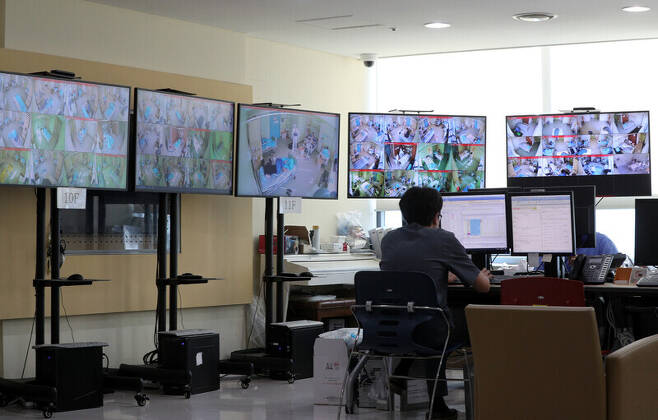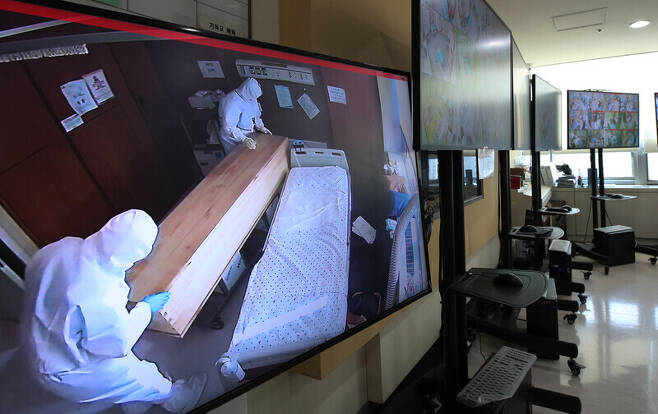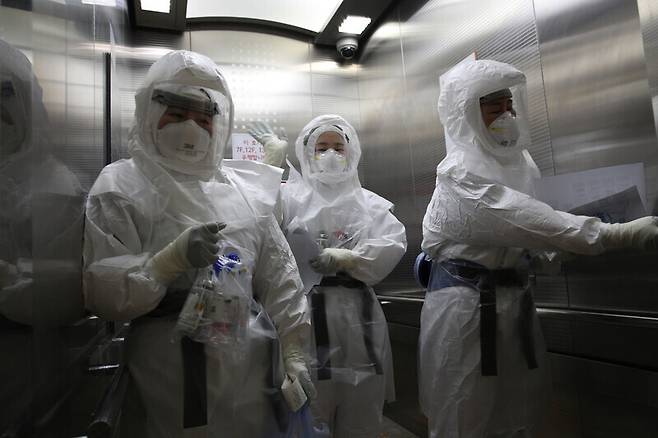The unending battle of public healthcare workers, still overworked and underpaid 1 year later
전체 맥락을 이해하기 위해서는 본문 보기를 권장합니다.
By spring 2020, the first wave seemed to be subsiding in the world outside the hospital. Inside, it was a different story. The conditions for lifting isolation (discharging) patients were much stricter in the early days, where there was little understanding of the new disease's characteristics. As a result, the number of patients at the hospital just kept growing, without any discharges to offset it. Choi Jae-pil, director of the infectious disease department, explained, "The number of patients hospitalized here reached 250 at one point when the Itaewon nightclub cluster occurred in Seoul in early May, and we didn't have enough beds."
As the second wave hit in August, healthcare workers had to contend not just with the virus, but with blazing summer heat. Inside of their protective gear, they would get soaked in sweat. Ahn recalled, "Once you put your gear on, you can't take it off for about three hours, so even when I was thirsty, I would hold off because I didn't want to have to go to the bathroom."
이 글자크기로 변경됩니다.
(예시) 가장 빠른 뉴스가 있고 다양한 정보, 쌍방향 소통이 숨쉬는 다음뉴스를 만나보세요. 다음뉴스는 국내외 주요이슈와 실시간 속보, 문화생활 및 다양한 분야의 뉴스를 입체적으로 전달하고 있습니다.

A row of large monitors stood in the COVID-19 situation room on the seventh floor of the Seoul Medical Center (SMC) in Seoul’s Jungnang District on Jan. 14. The monitors were partitioned into individual screens for each of 12 rooms; red bars would start lighting up every time a patient’s movements were detected. A red bar would come on when a young man looking at his cell phone rolled over from one side to the other. Red bars would flicker on the screen when nurses in protective gear emptied the trash can in one of the rooms.

As of that day, 211 COVID-19 patients were hospitalized at the SMC. Medical staff kept their eyes peeled as they monitored patients around the clock. If a patient were to faint or experience respiratory distress, they would need to scramble into their gear and take the elevator up to the isolation ward on the eighth to 13th floors.
Amid all the busily flickering red bars, some of the rooms showed little to no movement. Looking at one of them, I saw an elderly patient staring limply up at the ceiling, an oxygen supply line inserted in their nose. A green blanket drawn up to their chest did nothing to conceal the small and gaunt frame.
“That’s someone from a nursing hospital. These other two are the same. There have been a lot of infection clusters at nursing hospitals lately.”
Choi Soon-young, a nurse and division director for the COVID-19 ward, pointed at the rooms in question. There were no blinking red lights — it was like a freeze-frame. Looking at the monitors that day, I also saw the body of a patient being moved into a wooden coffin.

The first confirmed COVID-19 patients hospitalized at the SMC arrived on Jan. 30 of last year. They were the fifth and seventh patients to test positive nationally. In the roughly one year between their arrival and Jan. 14 of this year, a total of 2,416 COVID-19 patients were treated at the center. As a public hospital with over 600 beds and a medical institution with the capabilities to treat severe patients, it has both a large total of patients and a substantial number of patients requiring particular medical attention. In late February 2020, an infection cluster occurred at Cheongdo Dae Nam Hospital in North Gyeongsang Province, with some of the patients also requiring psychiatric treatment. With no other suitable place to transfer them, eight of them were hospitalized at the SMC.
Bolt from the blue: the first wave
For the most part, things have fallen into place now. In the early stages, however, it was utter chaos. Two days after its designation as a dedicated infectious disease hospital on Feb. 20 of last year, the hospital drew up a blueprint for the process of admitting COVID-19 patients. The idea was to minimize infection risk. Early on in the outbreak, the possibility of airborne transmission could not be ruled out, and a massive construction effort was carried out so that all of the air within the hospital rooms could be extracted. Around the same time, closed circuit cameras were set up in each room to observe patients.
“Back then, negative pressure equipment cost whatever the vendor said it did,” explained Kim Myeong-yoon, deputy director of the facilities team.
“There were no guidelines from the government telling us what to do. Everything was up to the hospital,” Kim recalled.
Ahn So-hyeon, a nurse for over five years, has been working in the COVID-19 ward for the past year as a steady stream of patients have come and gone.
“I never envisioned myself having to change someone’s diapers while wearing protective gear that’s so heavy and thick that it’s difficult to even move,” she said.
“With the patients from Cheongdo Dae Nam Hospital, it was difficult even communicating,” she recalled. In contrast, caring for younger patients with mild symptoms was a much simpler job, she added. Early on, Ahn vaguely imagined that the COVID-9 pandemic would be “over in three months or so.” A year later, she finds herself preparing for another year to come.

By spring 2020, the first wave seemed to be subsiding in the world outside the hospital. Inside, it was a different story. The conditions for lifting isolation (discharging) patients were much stricter in the early days, where there was little understanding of the new disease’s characteristics. As a result, the number of patients at the hospital just kept growing, without any discharges to offset it. Choi Jae-pil, director of the infectious disease department, explained, “The number of patients hospitalized here reached 250 at one point when the Itaewon nightclub cluster occurred in Seoul in early May, and we didn’t have enough beds.”
“It was a huge inflection point for healthcare institutions when the discharge conditions were relaxed on June 25, so that patients could be discharged based on a physician’s clinical determination without a need for polymerase chain reaction (PCR) testing,” Choi said.
Masks were another source of chaos early on the pandemic, and healthcare institutions were no exception.
“We didn’t have anything like this back then,” said Kim Ji-in, director of the purchasing and distribution team, indicating a pile of mask boxes stacked in a storage area on the center’s first basement level.
“We’d finished construction on the ward and the staff were all set. And here we were unable to see patients because we didn’t have the masks,” she recalled.
“Instead of cooperating, the hospitals were keeping their quantities and sources secret from each other. There was a fierce competition for supplies,” she added.

Growing burden as second and third waves intensify
As the second wave hit in August, healthcare workers had to contend not just with the virus, but with blazing summer heat. Inside of their protective gear, they would get soaked in sweat. Ahn recalled, “Once you put your gear on, you can’t take it off for about three hours, so even when I was thirsty, I would hold off because I didn’t want to have to go to the bathroom.”
“I just felt like latching on to anything cold,” she remembered.
Patients from Seoul’s Sarang Jeil Church, where disregard for disease control measures led to a massive infection cluster, were routinely uncooperative not only toward disease control authorities but also toward healthcare workers. When asked to check and share their blood pressure, they would turn off their phones; some would insist on accepting deliveries that could not be received at the center. Some of the patients would demand “room service” treatment, insisting that the hospital provide them with certain dishes.
The third wave has seen daily caseloads exceed 1,000 patients for days at a time. Both case numbers and infection rates have been incomparably higher than during past waves. By December, there was not an empty bed visible on the SMC’s monitor for its situation room. All of the dedicated infectious disease hospitals in the Seoul Capital Area (SCA) were wrestling with a shortage of space. At one point, temporary beds were set up in shipping containers on vacant hospital lots. Meanwhile, one cluster after another has erupted at nursing hospitals and nursing homes, compounding the burden on healthcare staff.
Some of the patients hospitalized at the SMC came from Misodle Nursing Hospital in Seoul’s Guro District, where patients quarantining in groups resulted in even more infections. With more and more patients arriving who are unable to do things for themselves, the nurses have to perform extra duties ranging from helping with meals to cleaning up urine and feces, periodically shifting patients’ posture, and treating bed sores. The intensity of their work has become increasingly extreme.
“It’s even more overwhelming because there’s no end in sight,” Ahn said.
Medical workers and other staff have posted messages throughout the center to cheer each other on. Pasted over two large mirrors in the corridor next to the elevator going up to the isolation ward is a message reading, “You’re looking at a hero right now.”

Another year of scrambling for healthcare workers
The third wave has shown signs of abating since 2021 began, but the situation at healthcare institutions remains a struggle. As of Jan. 14, the average age of the 211 patients hospitalized at the SMC was 73; most are senior citizens who require special care. Choi Jae-pil said, “A lot of them are people whose COVID-19 treatment is more or less complete and who just need nursing care, but they can’t leave because there’s nowhere for them to go.”
“Twenty-four patients have been hospitalized for four weeks or more, while another 70 have been here for over two weeks,” he explained, stressing the need for measures to deal with nursing hospital patients who can’t be discharged because of a lack of care facilities.
Choi also said, “I understand the nursing hospitals’ trepidation about accepting patients who had COVID-19, but we can’t prepare ourselves for a fourth or fifth wave if the number of long-term patients at dedicated COVID-19 hospitals just keeps growing like this.”

Having scrambled for the past year and facing another daunting year, healthcare workers said they often felt discouraged by the attitude of the government, which has simply called on public hospitals to “weather the difficulties.” Ahn singled out the matter of pay, noting that the nurses hurriedly recruited and dispatched by the Central Disease Management Headquarters to relieve the recent staff shortage are earning two to three times more than the nurses at dedicated COVID-19 hospitals. If the problem isn’t solved, it could lead to “more and more healthcare workers walking away and a collapse on the front lines,” she warned.
“Not long ago, I heard that nurses dispatched to community treatment centers [for COVID-19 patients with mild symptoms] are making 8 million won (US$7,250) a month — which I could never dream of earning — even though they aren’t treating the more difficult patients like we are. I felt like I’d been betrayed by the government,” she recalled.
Healthcare workers also agreed that the best way to respond to a bigger wave of infections would be to open up both public and private hospitals to COVID-19 patients.
“Social solidarity is the most crucial thing for overcoming disaster,” Choi Jae-pil said. During his interview, the phone on Choi’s desk kept ringing every 10 to 15 minutes. Quite a few of the calls were requests for the SMC to accept patients with no place for them to go.
“Yes, we’ll take them,” Choi said over the phone after one request. “Send a referral to our transfer cooperation office.”
By Choi Ha-yan and Suh Hye-mi, staff reporters
Please direct comments or questions to [english@hani.co.kr]
Copyright © 한겨레신문사 All Rights Reserved. 무단 전재, 재배포, AI 학습 및 활용 금지
- [포토] “커피 한잔” 부탁한 노숙인에게 점퍼·장갑까지 건넨 시민
- 카공족이 돌아왔다…손님·업주 “이제 숨통이 트일 것 같다”
- ‘마약 밀반입’ CJ 이재현 장남 이선호, 슬그머니 회사 복귀
- ‘복붙 보고서’로 특허청장상까지…공공기관 부실 공모전 ‘도마’
- 광주 유흥업소들 “벌금 물더라도 영업하겠다”
- “밍크고래 죽인 그물, 북극곰도 인간도 죽일 수 있다”
- 삼성 총수 부재에…“‘뉴삼성’ 투자 차질” “재벌개혁 출발점”
- ‘입양아 교체’라니…논란 부른 문 대통령 ‘아동학대 해법’
- 전주 콩나물국밥, 세계 9대 숙취해소 음식 선정
- 김동연 “서울시장 생각 없어…정치권 새판짜기 필요”